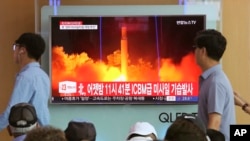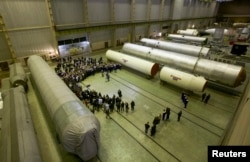North Korea has achieved great advancements in its missile capabilities over the past two years, fueled in part by what appear to be Soviet-style engines acquired from illicit networks in Russia and Ukraine, according to a report published Monday.
After a number of failed intermediate-range missile launches in 2016, North Korea has made mysteriously large steps in its development of missiles.
New evidence appears to show the country illicitly obtained technology for its Hwasong-14 and Hwasong-12 rockets from the European black market, writes Michael Elleman, a senior fellow for missile defense at the International Institute for Strategic Studies.
According to Ellerman, North Korea likely acquired a high-performance liquid-propellant engine “through illicit channels operating in Russia and/or Ukraine.”
In an interview with The New York Times, Ellerman said he thinks North Korea likely obtained the engines illegally from workers at Yuzhmash, a state-owned Ukrainian aerospace company.
Ellerman said executives at Yuzhmash likely were not involved in the deal, but he thinks workers at the plant likely supplied the engine to the North Koreans.
“It’s likely that these engines came from Ukraine — probably illicitly,” Elleman told the Times. “The big question is how many they have and whether the Ukrainians are helping them now. I’m very worried.”
Ukraine’s government flat-out denied the report that the rocket engine came from one of its state-owned factories and said Russian intelligence officials may be behind the allegations.
"This information is not based on any grounds, provocative by its content, and most likely provoked by Russian secret services to cover their own crimes,” according to Oleksandr Turchynov, head of Ukraine’s National Security and Defense Council.
Ukraine’s space agency said the RD-250 engine type reportedly used in North Korea was made in a Ukrainian factory, but only for use in rockets supplied to Russia.
Acting space agency chief Yuriy Radchenko told journalists the engines were produced at the Ukrainian plant until 2001 and a total of 233 were made.
He said, according to Ukrainian information, Russia has between 7 and 20 of the Cyclone rockets for which the engines were produced, and the Russians are free to “supply these engines from the finished rockets to whoever they want."









